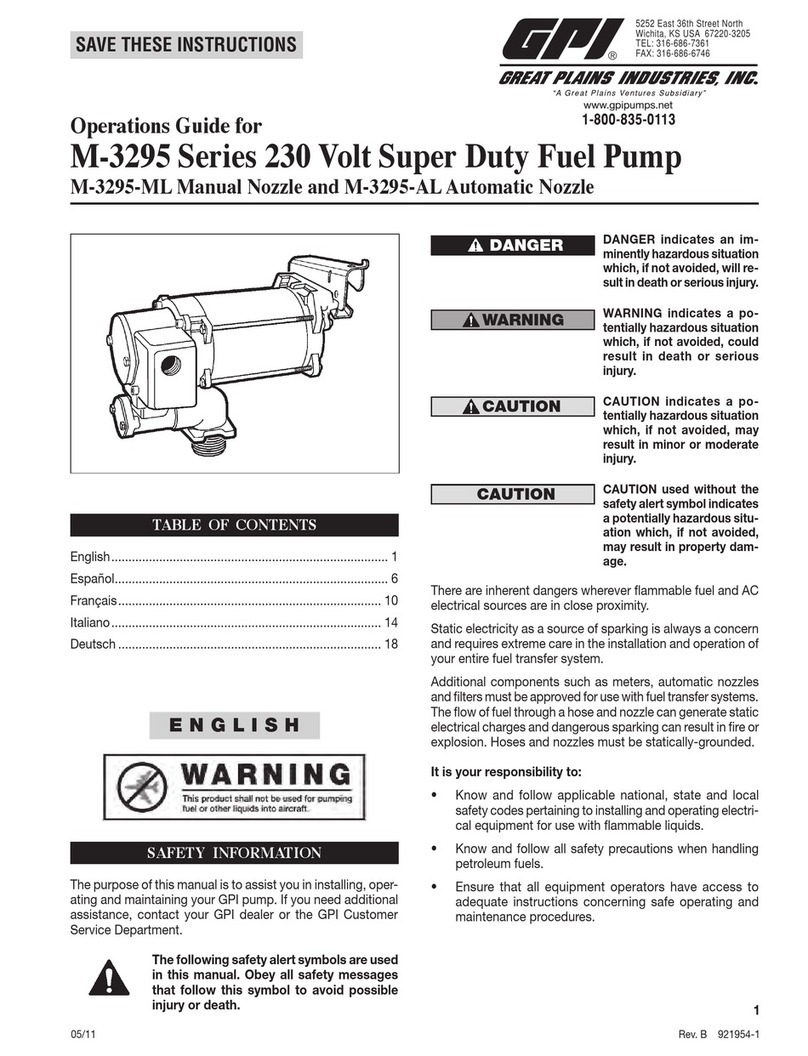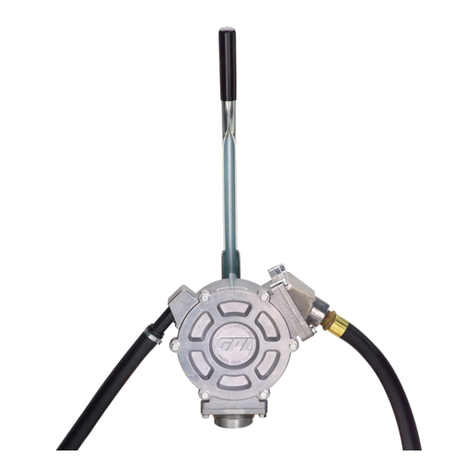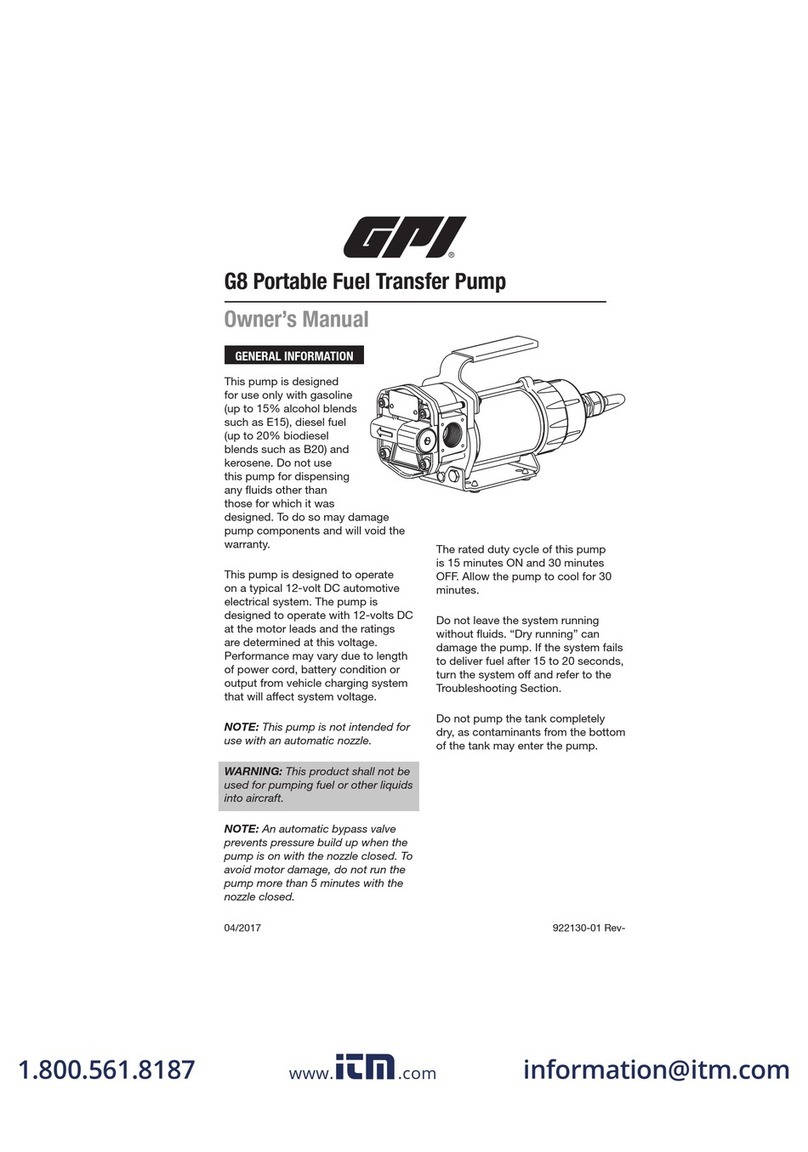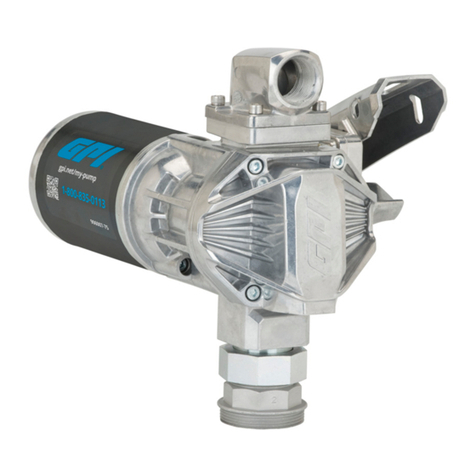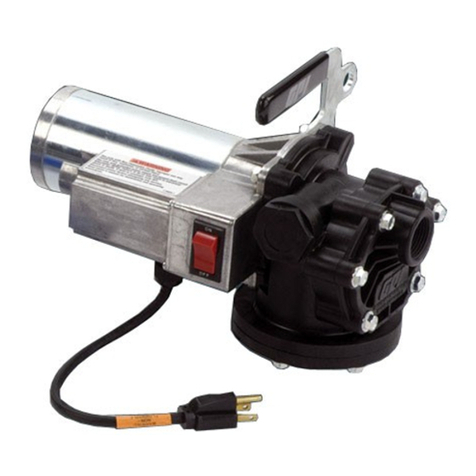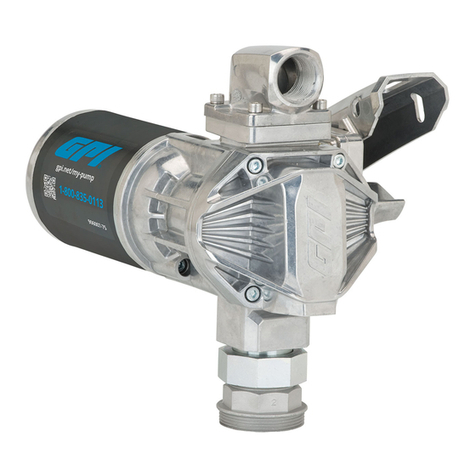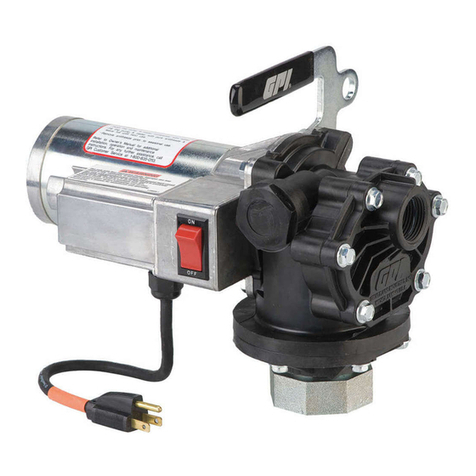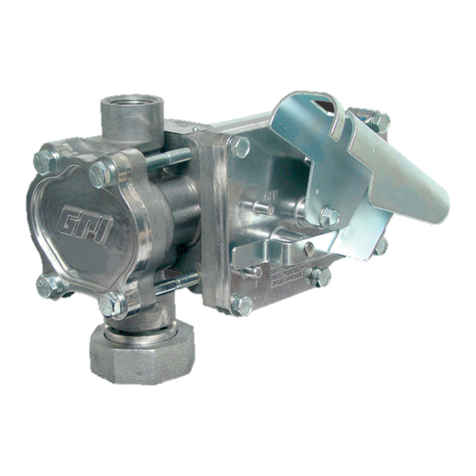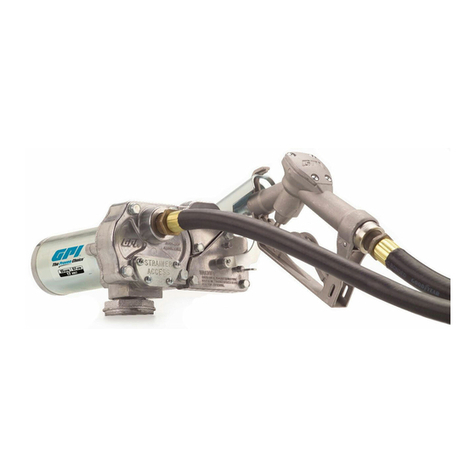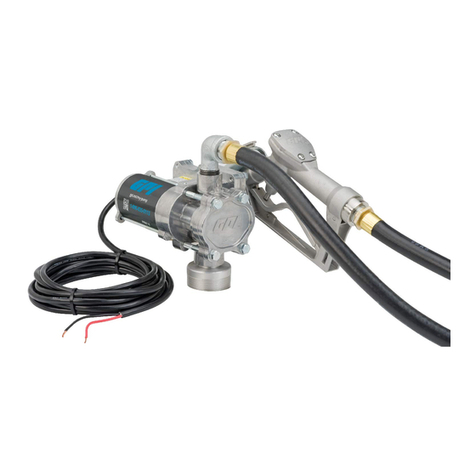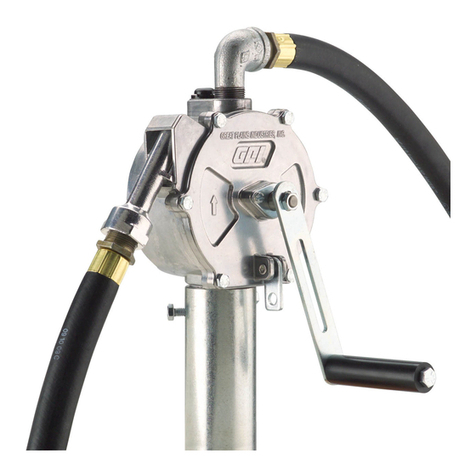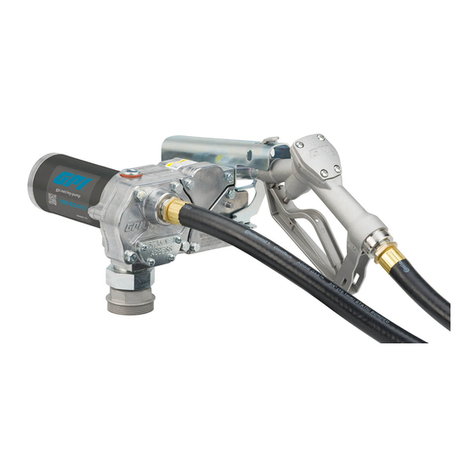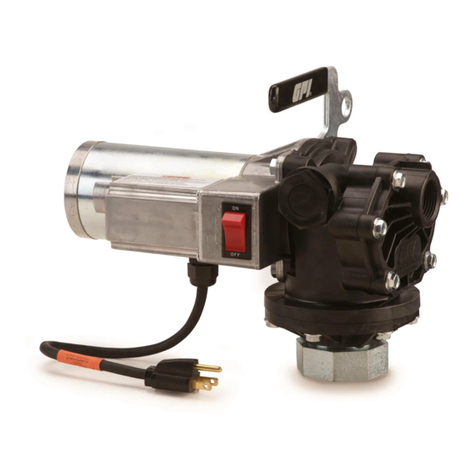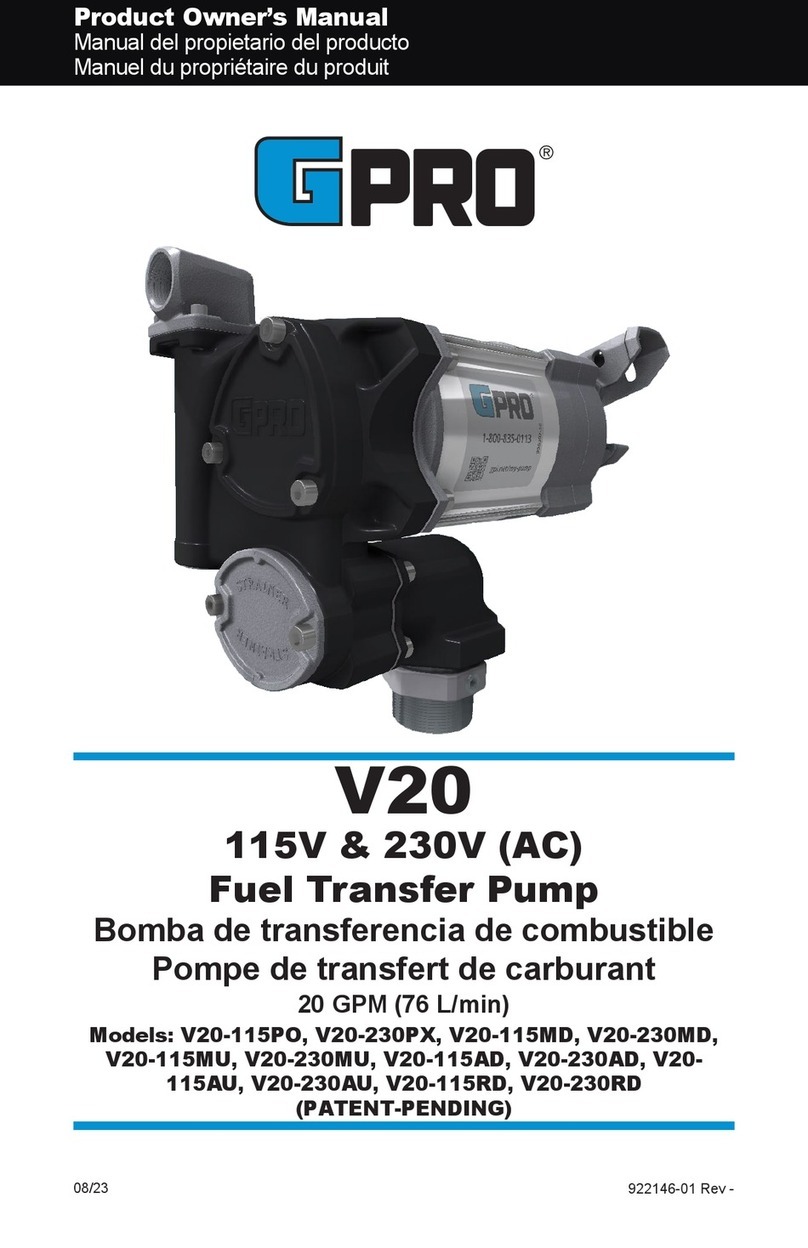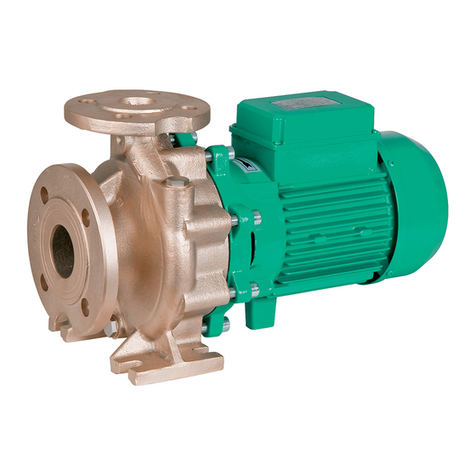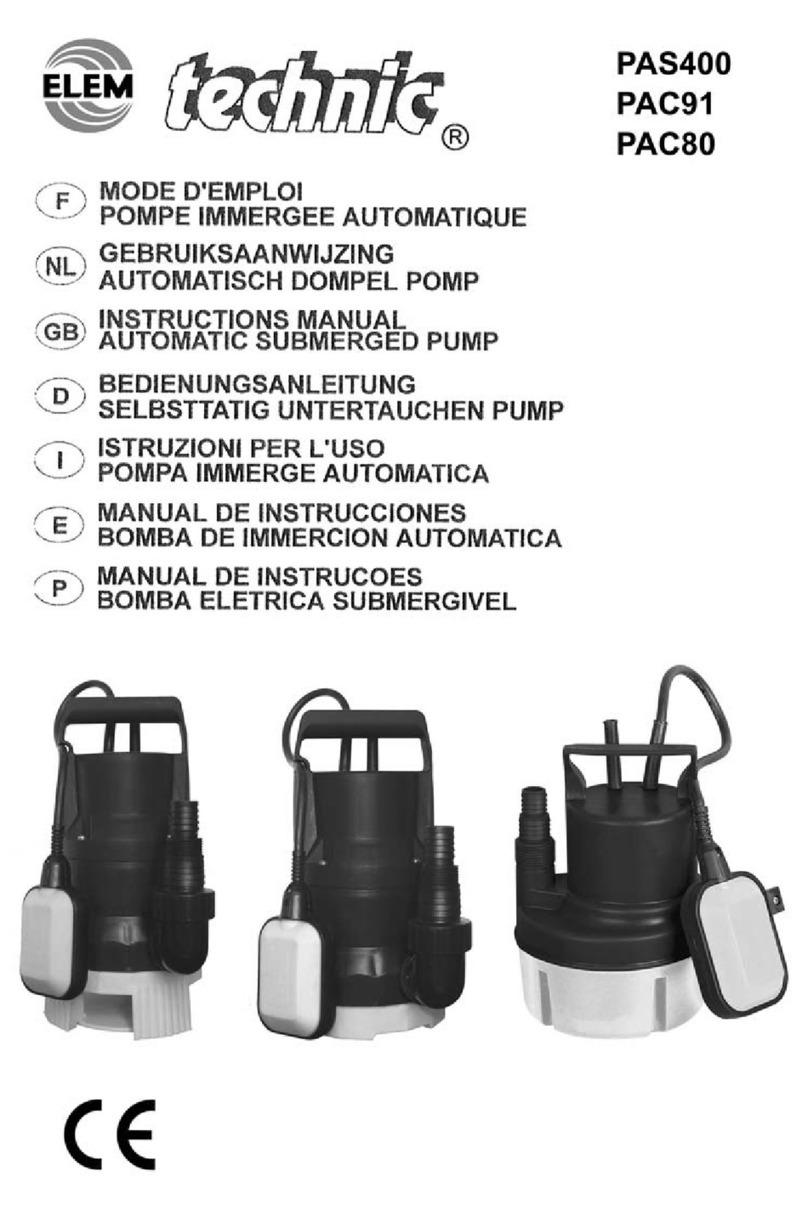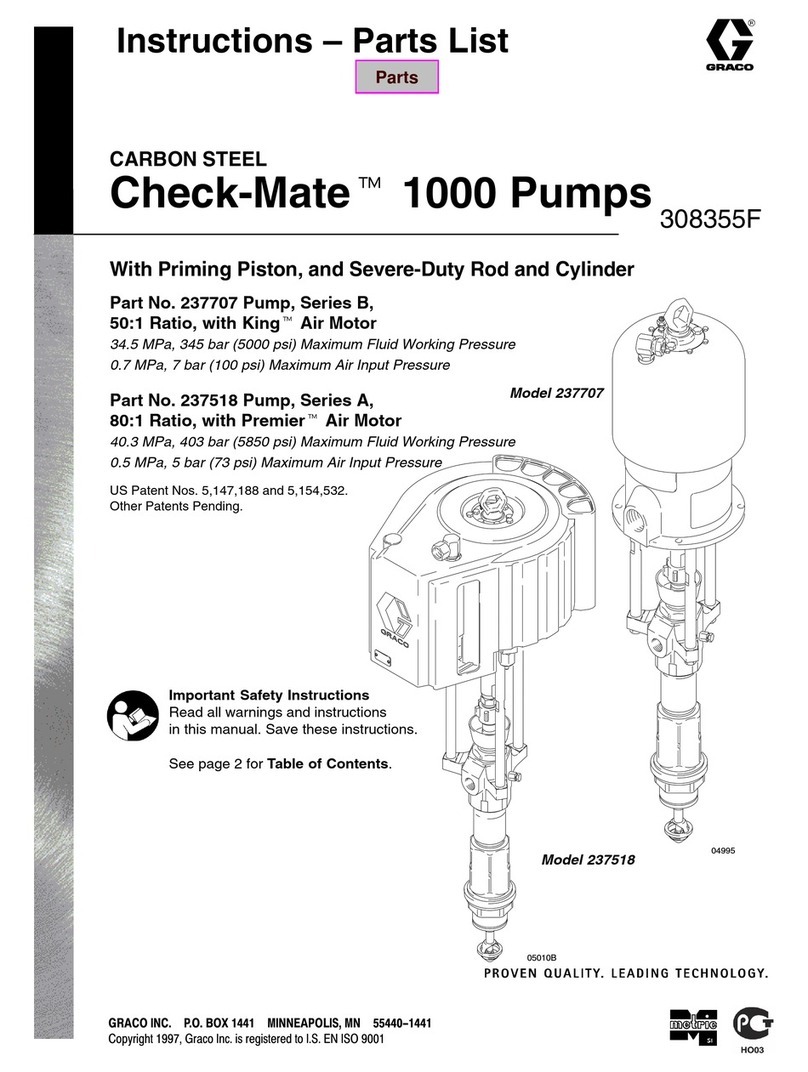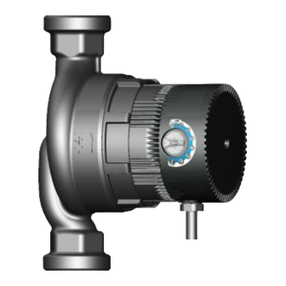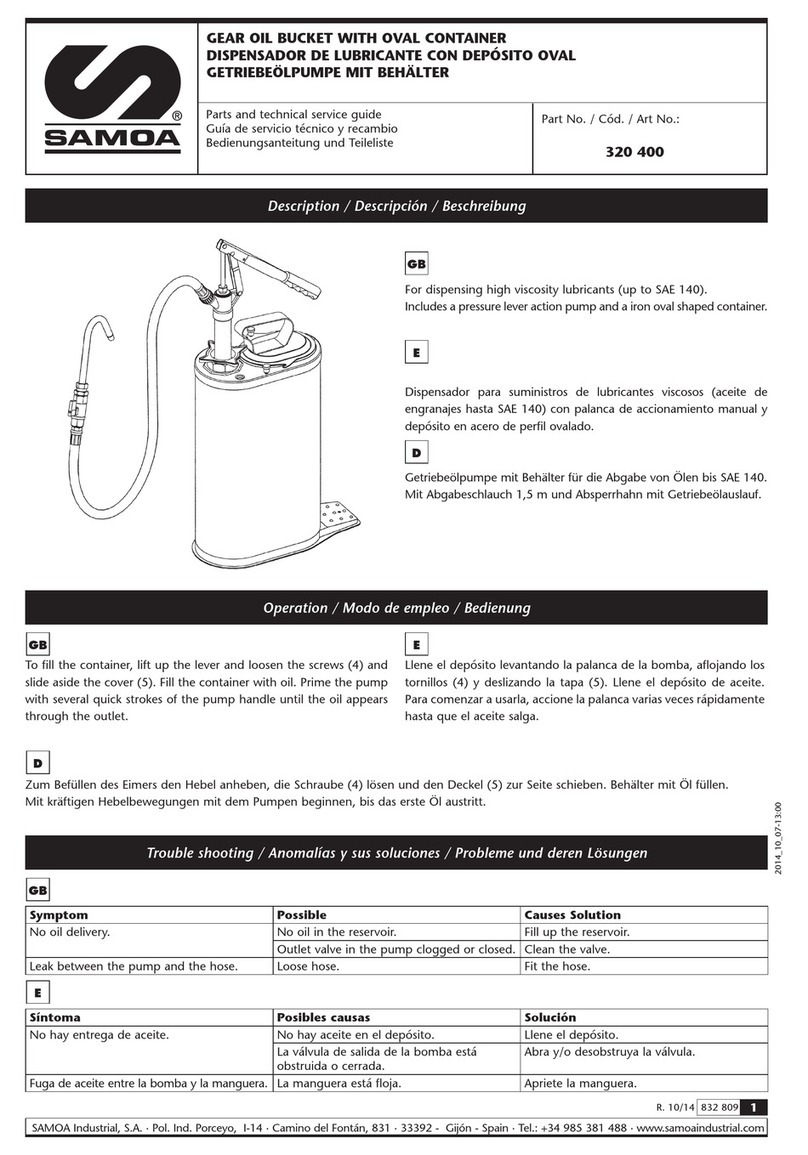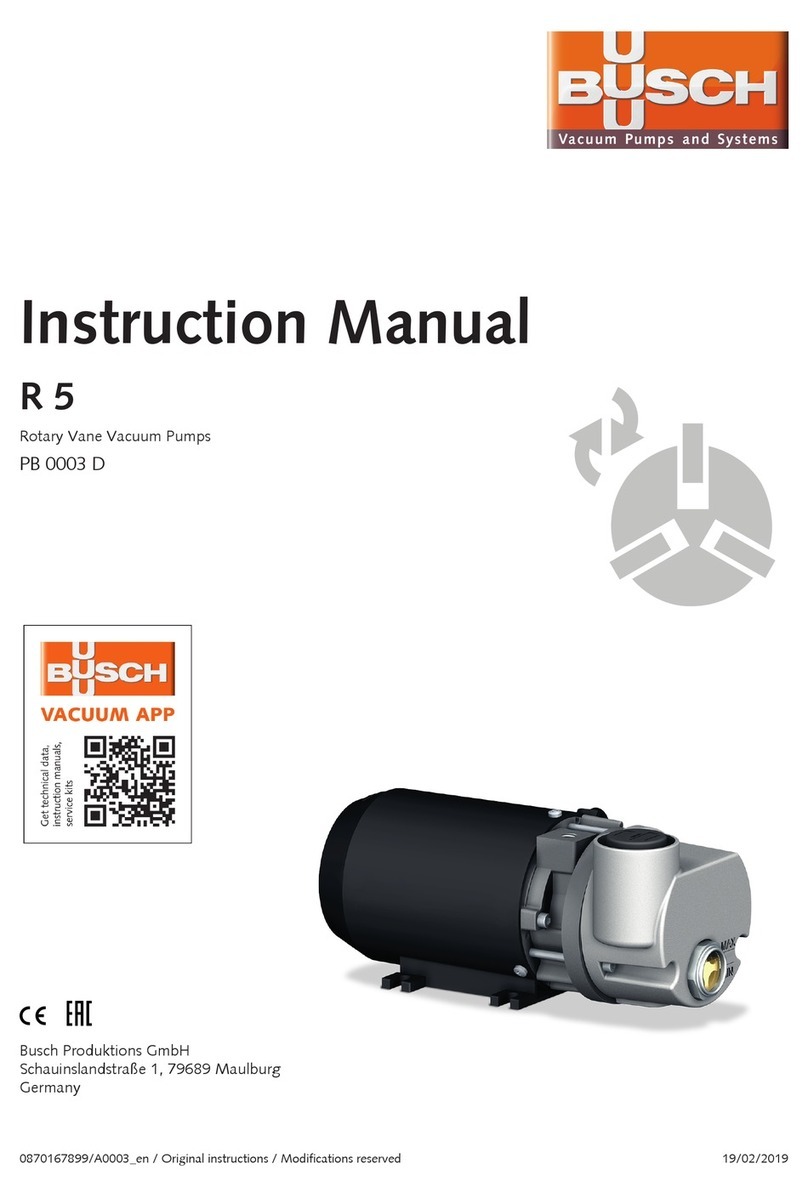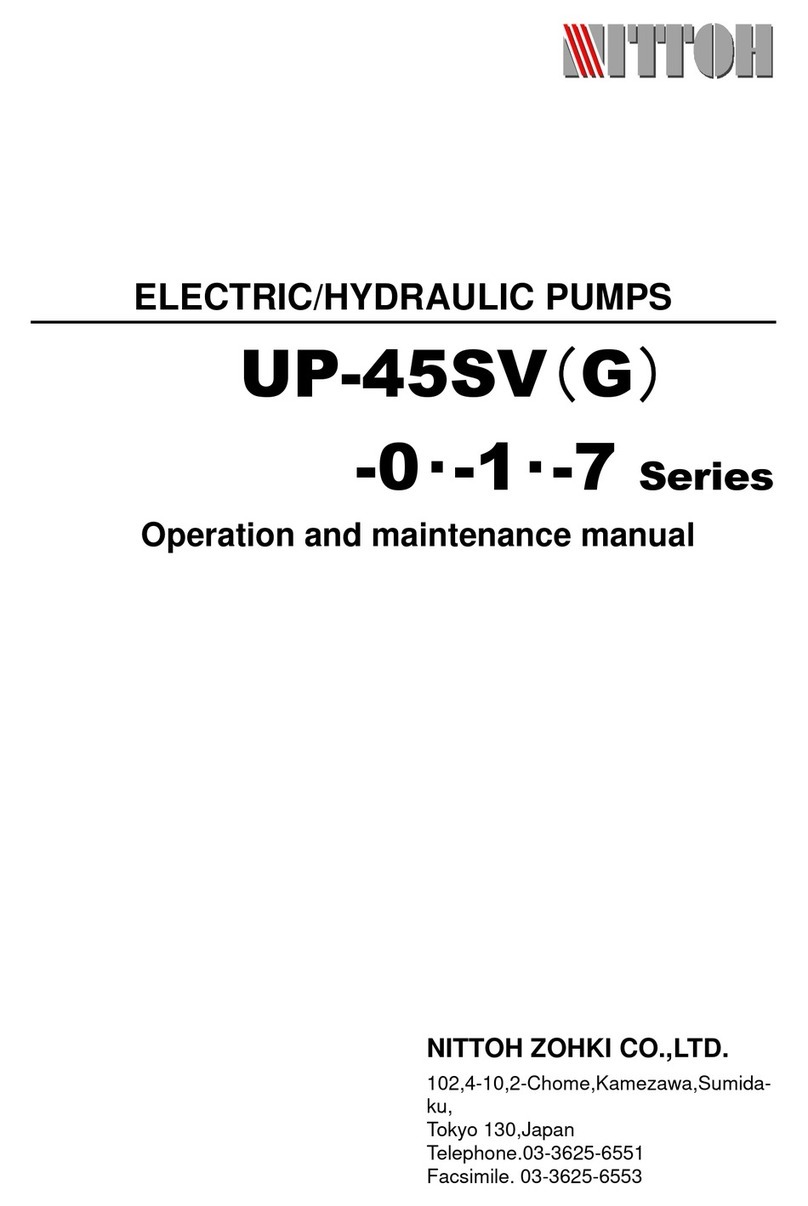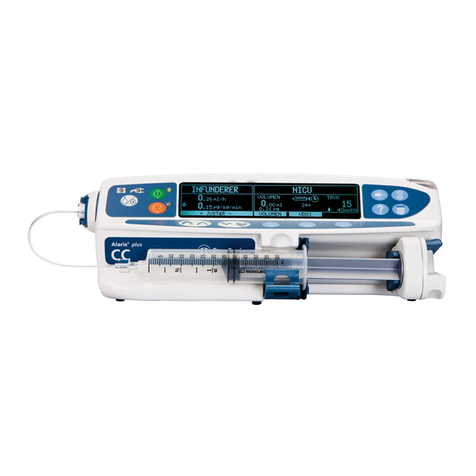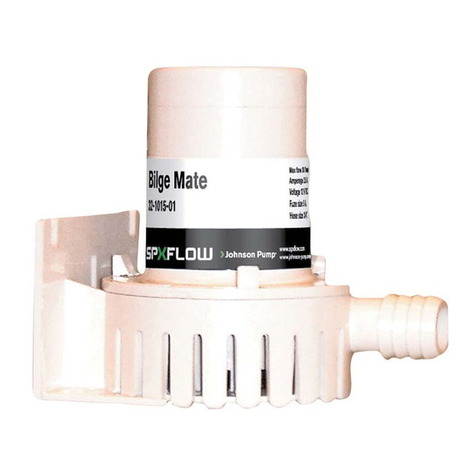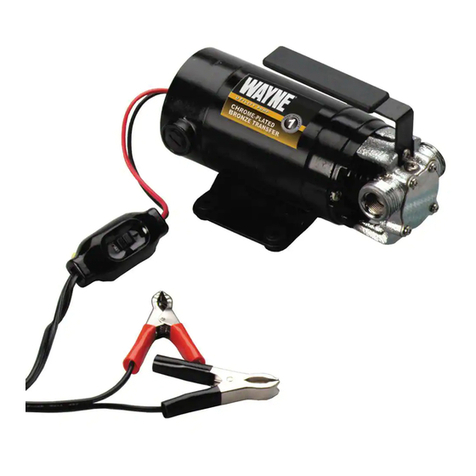GPI M-1115S-AU User manual

15 GPM (57 L/min)
120V (ac)
Fuel Transfer Pump
Models: M-1115S-AU, M-1115S-MU, M-1115S-PO
Product Owner’s Manual EN
921487-09Rev E
per ECN 5821
12/2020 SAVE THESE INSTRUCTIONS

Please save these instructions for future reference. Read carefully before attempting
to assemble, install, operate or maintain the product described.
Protect yourself and others by observing all safety information. Failure to comply
with instructions could result in personal injury and/or property damage.
Please refer to back cover for information regarding this product’s warranty and
other important information.
Thank you for choosing a Great Plains Industries product, and
congratulations on your purchase!
Headquartered in the heartland of the U.S., GPI strives
for integrity, innovation, continuous improvement, and
dependability—values you will immediately recognize when using
our products.
The maintenance policies and procedures outlined in this manual
emphasize our commitment to safety and our dedication to you
as a customer. By working together, we can ensure years of
reliable, quality service.
SAVE FOR YOUR RECORDS
Model #: ___________________
Serial #: ___________________
Purchase Date: _____________
DO NOT RETURN THIS PRODUCT TO THE STORE!
Please contact Great Plains Industries, Inc. before returning any product. If you are
missing parts, or experience problems with your installation, contact our Customer
Support Department. We will be happy to assist you.
Call: 800-835-0113 or 316-686-7361
Email: [email protected]
Website: gpi.net

1-EN
BEFORE YOU BEGIN
Fueling Requirements:
• This fuel pump is designed, tested and approved for use with gasoline
blends (up to E15), diesel fuel blends (up to B20) and kerosene. Pump
only models sold without a hose and nozzle are compatible with
aviation gasoline AVGAS 100LL and kerosene grade Jet A. Please
take all due precautions when handling these flammable liquids.
• Do not use this pump for dispensing any fluids other than those for
which it was designed. To do so may damage the pumps
components and will void the warranty.
Power Source Requirements:
• This manual covers 115-volt AC electric gear pump
M-1115S-MU, M-1115S-AU, and M-1115S-PO
•All M-1115S models should be connected to a 115-volt AC power
source only.
• Do not attempt connection to a 12-volt DC, 24-volt DC,or 230-volt AC
power source.
Tools Needed:
•Adjustable Wrench, Pipe Wrench, Pliers, Utility Knife, Wire Crimper/
Stripper and Thread Tape
UNPACKING
Contents:
• (1) 115-volt AC Fuel Transfer Pump with Spin Collar,
(1) Fiber Gasket and (1) Tank Adapter (all models)
• (1) Lockable Nozzle Holder (all models)
• (1) 12 foot (3.66 m) Dispensing Hose (M-1115S-MU & M-1115S-AU only)
• (1) 15 inch (38 cm) to 40 inch (101 cm) Adjustable Suction Pipe
(M-1115S-MU & M-1115S-AU only)
• (1) Automatic Unleaded Shut-off Nozzle (Model M-1115S-AU only) or
Manual Unleaded Shut-off Nozzle (Model M-1115S-MU only)
• (3) Plastic Wire Nuts (all models)
Inspect:
• After unpacking the unit, inspect carefully for any damage that may
have occurred during transit. Check for loose, missing or damaged
parts. Shipping damage claims must be filed with carrier.
• See General Safety Instructions on page 2, and Cautions and
Warnings as shown.
GETTING STARTED SAFETY /
SPECIFICATIONS
ASSEMBLY /
INSTALLATION OPERATION TROUBLESHOOTING MAINTENANCE /
REPAIR
tools.eps
box.eps
magnify_2.eps
warning symbol.eps
measure.eps
plug.eps
oil.eps
megaphone.eps
biohaz.eps
Battery_Caution1.eps
Caution.eps
Crush_Caution1.eps
Electrical_Caution.eps
Face_protection.eps
Fall_Hazard.eps
Fall_protection.eps
GearHand_Hazard.eps
Head_protection.eps
Heavy_Hazard.eps
Hot_surface.eps
Recycle.eps
Resp_protection1.eps
Resp_protection2.eps
Temp_Caution1.eps
body_protection.eps
chemical_Caution.eps
ear_protection1.eps
explosive_caution.eps
eye_protection1.eps
foot_protection.eps
hand_protection.eps
tools.eps
box.eps
magnify_2.eps
warning symbol.eps
measure.eps
plug.eps
oil.eps
megaphone.eps
biohaz.eps
Battery_Caution1.eps
Caution.eps
Crush_Caution1.eps
Electrical_Caution.eps
Face_protection.eps
Fall_Hazard.eps
Fall_protection.eps
GearHand_Hazard.eps
Head_protection.eps
Heavy_Hazard.eps
Hot_surface.eps
Recycle.eps
Resp_protection1.eps
Resp_protection2.eps
Temp_Caution1.eps
body_protection.eps
chemical_Caution.eps
ear_protection1.eps
explosive_caution.eps
eye_protection1.eps
foot_protection.eps
hand_protection.eps
tools.eps
box.eps
magnify_2.eps
warning symbol.eps
measure.eps
plug.eps
oil.eps
megaphone.eps
biohaz.eps
Battery_Caution1.eps
Caution.eps
Crush_Caution1.eps
Electrical_Caution.eps
Face_protection.eps
Fall_Hazard.eps
Fall_protection.eps
GearHand_Hazard.eps
Head_protection.eps
Heavy_Hazard.eps
Hot_surface.eps
Recycle.eps
Resp_protection1.eps
Resp_protection2.eps
Temp_Caution1.eps
body_protection.eps
chemical_Caution.eps
ear_protection1.eps
explosive_caution.eps
eye_protection1.eps
foot_protection.eps
hand_protection.eps
tools.eps
box.eps
magnify_2.eps
warning symbol.eps
measure.eps
plug.eps
oil.eps
megaphone.eps
biohaz.eps
Battery_Caution1.eps
Caution.eps
Crush_Caution1.eps
Electrical_Caution.eps
Face_protection.eps
Fall_Hazard.eps
Fall_protection.eps
GearHand_Hazard.eps
Head_protection.eps
Heavy_Hazard.eps
Hot_surface.eps
Recycle.eps
Resp_protection1.eps
Resp_protection2.eps
Temp_Caution1.eps
body_protection.eps
chemical_Caution.eps
ear_protection1.eps
explosive_caution.eps
eye_protection1.eps
foot_protection.eps
hand_protection.eps
tools.eps
box.eps
magnify_2.eps
warning symbol.eps
measure.eps
plug.eps
oil.eps
megaphone.eps
biohaz.eps
Battery_Caution1.eps
Caution.eps
Crush_Caution1.eps
Electrical_Caution.eps
Face_protection.eps
Fall_Hazard.eps
Fall_protection.eps
GearHand_Hazard.eps
Head_protection.eps
Heavy_Hazard.eps
Hot_surface.eps
Recycle.eps
Resp_protection1.eps
Resp_protection2.eps
Temp_Caution1.eps
body_protection.eps
chemical_Caution.eps
ear_protection1.eps
explosive_caution.eps
eye_protection1.eps
foot_protection.eps
hand_protection.eps

GENERAL SAFETY INSTRUCTIONS
IMPORTANT: It is your responsibility to:
• Know and follow applicable national, state and local safety codes
pertaining to installing and operating electrical equipment for use with
flammable liquids.
• Know and follow all safety precautions when handling petroleum fuels.
• Ensure that all equipment operators have access to adequate
instructions concerning safe operating and maintenance procedures.
Observe all safety precautions concerning safe handling of petroleum fuels.
To ensure safe operation, all fuel transfer
systems must be properly grounded. Proper
grounding means a continuous metal-to-metal contact from one
component to the next, including tank, tank mount, pump, meter,
filter, hose and nozzle. Care should be taken to ensure proper
grounding during initial installation and after any service or repair
procedures. For your safety, please take a moment to review the
warnings below.
To prevent physical injury or property damage,
observe precautions against fire or explosion
when dispensing fuel. Do not operate the system in the presence
of any source of ignition including running or hot engines, lighted
tobacco products, gas or electric heaters, or any type of electronic
device. A spark can ignite fuel vapors.
Observe precautions against electrical shock
when operating the system. Serious or fatal
shock can result from operating electrical equipment in damp
or wet locations.
Inspect external pump wiring regularly to
make sure it is correctly attached to the battery.
To avoid electrical shock, use extra care when connecting the pump
to power.
Avoid prolonged skin contact with petroleum
fuels. Use protective goggles, gloves and aprons
in case of splashing or spills. Change saturated clothing and wash
skin promptly with soap and water.
Observe precautions against electrical shock
when servicing the pump. Always disconnect
power before repairing or servicing. Never apply electrical power
to the system when any of the coverplates are removed.
If using solvent to clean pump components
or tank, observe the solvent manufacturer’s
recommendations for safe use and disposal.
MAINTENANCE /
REPAIR TROUBLESHOOTING OPERATION ASSEMBLY /
INSTALLATION
2-EN
SAFETY /
SPECIFICATIONS GETTING STARTED
See page 21 for explanation of ISO Safety Symbols pictured above

3-EN
GETTING STARTED SAFETY /
SPECIFICATIONS
ASSEMBLY /
INSTALLATION OPERATION TROUBLESHOOTING MAINTENANCE /
REPAIR
SPECIFICATIONS
M-1115S-PO
M-1115S-AU
M-1115S-MU
Housing Material Lightweight, corrosion-resistant, cast aluminum body,
convenient union ring for easy installation.
Pump Rate Up to 12 GPM (45 LPM)
Duty Cycle Intermittent, 30 minute ON, 30 minute OFF
Suction Lift Manual Nozzle: Up to 5.5 feet (1.7 m)
Automatic Nozzle: Up to 4.8 feet (1.5 m)
Operating
Temperature -20 °F to 125 °F (-29 °C to 52 °C)
Operating
Pressure 15 PSI (1.03 bar)
Input 115-volt AC
Current Draw 1.8 amps
Motor 1400 RPM, 1/8 hp
Motor Approval cULus Listed, Class I Div 1
Thermal Motor
Protection Auxiliary Temperature Limiting Device
Tank Adapter 2 inch NPT
Inlet 1 inch NPT
Outlet 3/4 inch NPT
Hose Type N/A Buna-N Electrically Conductive
Discharge Hose with Static Wire
Hose Size N/A 3/4 inch x 12 feet (3.6 m)
Nozzle N/A 3/4 inch Automatic
Unleaded
3/4 inch Manual
Unleaded
Weight 14 lbs. (6.3 kg) 23 lbs. (10.4 kg) 22 lbs. (9.9 kg)
AVIATION FUELING
"Pump Only" models sold without a hose or nozzle are approved for ground-based
refueling only. Do not use in or on aircraft. User must provide hose, suction pipe,
nozzle, and accessories that meet the appropriate NFPA 407 Standard for Aircraft Fuel
Servicing. Pumps have no actual or implied compliance with this standard. Please
consult NFPA 407 for recommended safety requirements during ground fuel servicing of
aircraft using petroleum fuels.

MAINTENANCE /
REPAIR TROUBLESHOOTING OPERATION ASSEMBLY /
INSTALLATION
SAFETY /
SPECIFICATIONS GETTING STARTED
4-EN
SPECIFICATIONS (CONTINUED)
All M-1115S models
Dimensions Inches (cm)
A. Pump Ass’y Width 9.13 (23.2)
B. Pump Ass’y Height 4.95 (12.6)
C. Pump Ass’y Height
w/Nozzle Holder 6.74 (17.1)
D. Pump Ass’y Depth 10.45 (26.5)
Figure 1
B
D
A
C

5-EN
GETTING STARTED SAFETY /
SPECIFICATIONS
ASSEMBLY /
INSTALLATION OPERATION TROUBLESHOOTING MAINTENANCE /
REPAIR
INSTALLATION INSTRUCTIONS
Mechanical Connections
NOTE: All threaded fuel connections must be sealed with thread tape or a
pipe thread sealing compound approved for use with petroleum fuels and
tightened securely to prevent leakage.
NOTE: This pump must be mounted on a vented tank. If the tank is not
vented, contact Grainger for the correct vent.
NOTE: This pump is designed to mount directly to a standard 2 inch female
tank adapter (included) (see Figure 2). The suction pipe should extend to
within 3 inches (7.62 cm) of tank bottom. Apply thread tape to the suction
pipe thread and securely tighten the suction pipe to the pump inlet port.
NOTE: This pump is designed to self-prime with dry gears. Expect suction
lift as follows:
Manual Nozzle: 5.5 feet (1.7 m) with diesel
6.7 feet (2.1 m) with gasoline
Automatic Nozzle: 4.8 feet (1.5 m) with diesel
5.8 feet (1.8 m) with gasoline
If you require a greater initial prime height, coat the gears with fluid by
removing the plug on the top of the pump and pour a small quantity of
motor oil into the gear cavity. Replace the plug and try again. Afoot valve
with pressure relief may be needed to maintain prime.
Install Tank Adapter and Suction Pipe
NOTE: Suction pipe is not included with model M-1115S-PO.
Wrap the 2" threaded end of the tank adapter with three or four turns of
thread tape (see Figure 2). Using a pipe wrench, tighten the adapter
snugly into the fuel tank.
NOTE: For Aluminum Tank Installation - To prevent thread galling of
aluminum fittings, always prepare the threads for assembly using an
anti-seize compound such as Loctite®567TM, Hernon®Dripstop®940,
or equivalent.
1. Using pliers, remove the plastic plug from inlet port on bottom of pump.
Place the spin collar gasket into the inlet fitting on the bottom of the
pump (see Figure 3).
2. Wrap the threaded end of suction pipe with three or four turns of thread
tape (see Figure 4). Thread the suction pipe into the inlet port on the
bottom of the pump and hand tighten until snug (see Figure 5).
NOTE: If your tank is 15 - 24 inches deep, do not use the included suction
pipe extension; if your tank is 24 - 40 inches deep, attach the suction pipe
extension (see Figure 6).

MAINTENANCE /
REPAIR TROUBLESHOOTING OPERATION ASSEMBLY /
INSTALLATION
SAFETY /
SPECIFICATIONS GETTING STARTED
6-EN
INSTALLATION INSTRUCTIONS (CONTINUED)
Figure 7
Figure 6
15” - 24” Telescoping Suction Pipe
24” - 40” Extension Pipe
Install Pump on Tank
1. Clean the tank interior of all dirt and foreign material.
2. Carefully lift pump / suction pipe assembly and insert suction pipe into
the tank opening after telescoping suction pipe out.
While holding the spin collar gasket in place, position the pump spin collar
onto the tank adapter and tighten using a pipe wrench, making sure the
spin collar is not cross-threaded (see Figure 7); The spin collar measures
2.26 inches (57.40 mm) across flats.
NOTE: To prevent pressure buildup and possible fuel leaks through the
nozzle, make sure the fuel tank is properly vented. A vent cap rated at
3 psi (20.68 kPa) or less is recommended.
Figure 2
Figure 4
Figure 3
Figure 5

7-EN
GETTING STARTED SAFETY /
SPECIFICATIONS
ASSEMBLY /
INSTALLATION OPERATION TROUBLESHOOTING MAINTENANCE /
REPAIR
INSTALLATION INSTRUCTIONS (CONTINUED)
Install Hose and Nozzle
NOTE: Dispensing hose and nozzle are not included with model M-1115S-PO.
1. Using pliers, remove the plastic plug from outlet port on front of pump.
Wrap one end of the dispensing hose with three to four turns of thread
tape and thread into outlet port (see Figure 8). Tighten securely using
an adjustable wrench.
2. Wrap opposite end of hose with three or four turns of thread tape and
thread into nozzle. Tighten securely using an adjustable wrench
(see Figure 9).
3. Place the nozzle into the nozzle holder on the end of the pump motor
housing. Note that the nozzle cannot be placed in the holder unless
the pump switch is OFF (see Figure 10).
Figure 9
Figure 10
Figure 8

INSTALLATION INSTRUCTIONS (CONTINUED)
Connect to a Power Source
IMPORTANT: The pump is designed for use with a 115-volt power source.
Do not attempt installation on a 12-volt, 24-volt or 230-volt system.
Observe precautions against electrical shock
when servicing the pump. Always disconnect
power before repairing or servicing. Never apply electrical power
to the system when any of the coverplates are removed.
It is important to exercise more than ordinary
care with electrical installation and maintenance.
Failure to follow these electrical connection instructions could
result in death or serious injury from shock, fire or explosion.
IMPORTANT: Electrical wiring and connections must be made only by a
licensed electrician in accordance with national, state and local electrical
codes regarding Class I, Division 1 requirements as well as NFPA Code
70 and 30. Other codes may apply.
1. Install UL Listed, rigid metal conduit and code-specified gasoline
and oil-resistant wire with ground wire from switch box to the pump
electrical box, using proper seal offs.
2. Remove the electrical coverplate (see Figure 11). Be careful not to
damage gasket.
3. Route the wiring and conduit to the pump.
4. Attach wiring to pump wires using provided wire nuts.
5. Position all wires inside the pump electrical cavity and replace
the coverplate.
MAINTENANCE /
REPAIR TROUBLESHOOTING OPERATION ASSEMBLY /
INSTALLATION
SAFETY /
SPECIFICATIONS GETTING STARTED
8-EN
Figure 11
Green Ground
Screw

GETTING STARTED SAFETY /
SPECIFICATIONS
ASSEMBLY /
INSTALLATION OPERATION TROUBLESHOOTING MAINTENANCE /
REPAIR
9-EN
GETTING STARTED SAFETY /
SPECIFICATIONS
ASSEMBLY /
INSTALLATION OPERATION TROUBLESHOOTING MAINTENANCE /
REPAIR
OPERATION
IMPORTANT: Always follow safety precautions when operating this
equipment. Review the Safety Instructions.
To prevent physical injury or property damage,
observe precautions against fire or explosion
when dispensing fuel. Do not operate the system in the presence
of any source of ignition including running or hot engines, lighted
tobacco products, gas or electric heaters, or any type of electronic
device. A spark can ignite fuel vapors.
Before each use, repair leaks around seals or
connections. Make sure hoses are in good
condition and connections are tight.
NOTE: Make sure the work area is dry.
Make sure the pump is properly grounded. Repair
any corroded or damaged wiring before use.
NOTE: Ensure the tank contains enough fuel.
IMPORTANT: Make sure the fuel is not contaminated with debris.
Tighten loose tank lids regularly.
Dispensing Fuel
1. Turn on the pump by removing the nozzle from the holder and pushing
up the switch lever. Insert the nozzle into the receiving tank and
squeeze the handle to start fuel flow. When done, release the nozzle
handle, turn the pump off and return the nozzle to its holder.
IMPORTANT: This pump is designed to be self-priming. If fuel is not
delivered within 15 to 20 seconds, turn the pump off and refer to priming
information in the Troubleshooting Section.
An automatic bypass valve prevents pressure build
up when the pump is on with the nozzle closed. To
avoid pump damage, do not run the pump more than 10 minutes with
the nozzle closed.
Never leave the pump running without fluid. Dry
running can damage the pump components, and
will void the warranty.
IMPORTANT: This is an intermittent duty pump, after running the pump
for a maximum of 30 minutes, allow it to cool for 30 minutes.
Thermal Motor Protector
IMPORTANT: The motor is provided with an internal auxiliary
temperature-limiting device. Excessive motor heat can trip the device.
It resets automatically after the motor has cooled.
1. If the auxiliary temperature limiting device trips, reset by turning the
switch OFF. Let the pump cool then turn ON again. If the device
trips again, see the Troubleshooting Section of this manual.
Always turn the pump off if the temperature-
limiting device trips. If left on, the pump will
automatically reset when cool and start pumping.
Never leave pump running unattended.

MAINTENANCE /
REPAIR TROUBLESHOOTING OPERATION ASSEMBLY /
INSTALLATION
SAFETY /
SPECIFICATIONS GETTING STARTED
10-EN
TROUBLESHOOTING
Symptom Possible Cause(s) Corrective Action
Motor does not run 1. Switch defective 1. Remove switch coverplate
and inspect switch. Replace,
if necessary
2. Switch or electrical
connections are faulty
2. Inspect for damaged motor
protector, defective wiring or
switch, or improper electrical
connections. Replace as
needed and reinstall
3. Auxiliary temperature
limiting device tripped
3. Turn power off at source.
Inspect the pump thoroughly;
clean or repair. Reset device
by turning the power switch off.
Allow the pump to cool, then
turn power switch back on
4. Motor burned out 4. Replace motor (see
Maintenance / Repair section)
Motor runs but
doesn’t pump
1. Gear coverplate or
O-ring damaged
1. Remove and inspect the
coverplate and O-ring.
Replace, as necessary. (see
Maintenance / Repair section)
2. Strainer clogged or
defective
2. Remove strainer coverplate.
Remove and clean strainer.
Install again
3. Suction pipe clogged,
damaged or missing
3. Remove pump from tank.
Inspect suction pipe. Clean
or replace, as necessary
4. Bypass poppet O-ring
worn or missing
4. Inspect O-ring (see
Maintenance / Repair section).
Replace, if necessary
5. Bypass poppet
O-ring dirty
5. Remove poppet assembly
and clean poppet and cavity
6. Bypass poppet binding
or damaged
6. Remove the bypass poppet,
spring and O-ring. Clean
cavity. Inspect and replace
components, if needed

11-EN
GETTING STARTED SAFETY /
SPECIFICATIONS
ASSEMBLY /
INSTALLATION OPERATION TROUBLESHOOTING MAINTENANCE /
REPAIR
TROUBLESHOOTING (CONTINUED)
Symptom Possible Cause(s) Corrective Action
Motor runs but doesn’t
pump (continued)
7. System air leak 7. Tighten all pump fittings and
connections. Inspect suction
pipe for leaks or damage
8. System air lock 8. Occurs if external filter,
meters or an off-the-shelf
automatic nozzle is used.
To correct, remove the
pipe plug in the top outlet
port and fill the gear cavity
with fuel. Use of a factory-
supplied automatic nozzle
is recommended
9. Poor connections or low
voltage
9. Make sure electrical
connections are secure
10.Fuel level low 10.Fill tank
Low flowrate 1. Strainer partially
clogged
1. Remove the strainer
coverplate. Remove and
clean the strainer. Install
again
2. Poor connections
or low voltage
2. Make sure electrical
connections are secure.
Also check power source
3. Suction pipe clogged
or damaged
3. Remove pump from tank.
Inspect suction pipe. Clean
or replace, as necessary
4. Using off-the-shelf
automatic nozzle
4. Factory-supplied automatic
nozzle is recommended
5. System air leak 5. Tighten all pump fittings and
connections. Inspect suction
pipe for leaks or damage.
Replace, as necessary
6. Bypass poppet
spring weak
6. Remove the bypass poppet
and inspect spring (see
Maintenance/Repair section.
Replace, if necessary
7. Fuel tank empty 7. Fill tank

MAINTENANCE /
REPAIR TROUBLESHOOTING OPERATION ASSEMBLY /
INSTALLATION
SAFETY /
SPECIFICATIONS GETTING STARTED
12-EN
TROUBLESHOOTING (CONTINUED)
Symptom Possible Cause(s) Corrective Action
Motor stalls when
operating in bypass
mode
1. Gears locked 1. Remove gear coverplate
and inspect gears and drive
key. Make sure gears turn
freely with the key removed.
Replace, if worn
2. Bypass poppet
binding or damaged
2. Using instructions in the
Repair Section, remove the
bypass poppet, spring and
O-ring. Clean cavity. Inspect
components and replace,
as necessary
3. Wiring defective 3. Use Wiring instructions in the
Installation Section to ensure
proper connections
4. Motor defective 4. Replace motor as described
in the Repair Section
Switch fails to
operate motor
1. Switch or electrical
connections faulty
1. Inspect for defective wiring or
switch, or improper electrical
connections. Replace or
install again, as necessary.
Refer to Switch Replacement
instructions in the Repair
Section
2. Motor burned out 2. Replace motor as described
in the Repair Section

13-EN
GETTING STARTED SAFETY /
SPECIFICATIONS
ASSEMBLY /
INSTALLATION OPERATION TROUBLESHOOTING MAINTENANCE /
REPAIR
TROUBLESHOOTING (CONTINUED)
Symptom Possible Cause(s) Corrective Action
Overheating of motor 1. Duty cycle too long 1. Pump operation should not
exceed the standard duty
cycle of 30 minutes ON, and
30 minutes OFF. Allow the
pump to cool for 30 minutes
2. Strainer clogged 2. Remove strainer coverplate.
Remove and clean strainer.
Install again
3. Suction pipe clogged
or damaged
3. Remove pump from tank.
Inspect suction pipe. Clean
or replace, as necessary
4. Gears worn 4. Remove gear coverplate and
inspect gears and drive key.
Make sure gears turn freely
with key removed. Replace,
if necessary
5. Fuel level low 5. Fill tank
6. Running too long
in bypass mode
6. Limit bypass operation
to 10 minutes

MAINTENANCE
NOTE: This pump is designed for minimum maintenance. The motor
bearings are sealed and require no lubrication. Inspect the pump and
components regularly for fuel leaks and make sure the hose and power
cord are in good condition. Keep the pump exterior clean to help
identify leaks.
IMPORTANT: Do not use this pump for water, chemicals or herbicides.
Dispensing any fluid other than those listed in this manual will damage the
pump. Use of the pump with unauthorized fluids will void the warranty.
Clean or Replace Strainer
1. Turn the pump off and disconnect from power. Remove the strainer
coverplate, making sure not to damage the O-ring (see Figure 14).
Remove the inlet strainer and inspect for damage or clogs (see
Figure 12). Clean the strainer with a soft-bristled brush and solvent
(see Figure 13). If the strainer is very dirty, compressed air may be
used. If damaged, replace the strainer.
2. Place the strainer in the cavity. Clean the coverplate and O-ring. Coat
the O-ring lightly with grease. Ensure the coverplate O-ring is properly
seated (see Figure 14) and tighten the strainer coverplate.
MAINTENANCE /
REPAIR TROUBLESHOOTING OPERATION ASSEMBLY /
INSTALLATION
SAFETY /
SPECIFICATIONS GETTING STARTED
14-EN
Figure 12
Figure 14
Figure 13

GETTING STARTED SAFETY /
SPECIFICATIONS
ASSEMBLY /
INSTALLATION OPERATION TROUBLESHOOTING MAINTENANCE /
REPAIR
15-EN
GETTING STARTED SAFETY /
SPECIFICATIONS
ASSEMBLY /
INSTALLATION OPERATION TROUBLESHOOTING MAINTENANCE /
REPAIR
REPAIR
IMPORTANT: Carefully inspect all parts for wear or damage. Replace
components, as necessary. The Illustrated Parts List gives information
on replacement parts and kits. Review the Safety Instructions before
proceeding.
Observe precautions against electrical shock
when servicing the pump. Always disconnect
power before repairing or servicing. Never apply electrical power
to the system when any of the coverplates are removed.
Avoid prolonged skin contact with petroleum
fuels. Use protective goggles, gloves and aprons
in case of splashing or spills. Change saturated clothing and wash
skin promptly with soap and water.
Remove Pump From Tank
1. Turn the pump OFF and disconnect from power.
2. Turn the spin collar counterclockwise to release the inlet fitting.
3. Lift the pump and suction pipe straight up from the tank adapter.
4. Elevate the nozzle and hose to allow excess fuel to drain into the tank.
5. Wipe the entire system with a clean cloth.
Service O-rings
NOTE: A Wet Seal Kit contains all seals for your pump and should be on hand
when performing repairs. Old seals may then be replaced with new seals.
1. In general, when inspecting O-rings, look for breaks, wear and signs
of deterioration, such as swelling.
2. Replace, as necessary.
3. Before seating, coat O-rings with light grease.
Replace Gears and Drive Key
1. Turn the pump OFF and disconnect from power.
2. Remove the gear coverplate and O-ring from the pump housing.
3. Pull the drive key and two gears from the pump (see Figure 16).
4. Inspect the gears and key for wear and damage. Replace, as
necessary.
5. Wipe the gear cavity with a clean cloth.
6. Replace the gears. Make sure they turn freely.
7. Replace the drive key.
8. Make sure the gear coverplate O-ring is securely in place. Tighten the
coverplate to the housing.

MAINTENANCE /
REPAIR TROUBLESHOOTING OPERATION ASSEMBLY /
INSTALLATION
SAFETY /
SPECIFICATIONS GETTING STARTED
16-EN
REPAIR (CONTINUED)
Clean Bypass Poppet
1. Turn the pump OFF and disconnect from power.
2. Using a 1/2” drive wrench, remove the pipe plug from the top outlet port
(see Figure 15).
3. Remove the gear coverplate and O-ring from the pump housing.
4. Pull the drive key and two gears from the pump (see Figure 16).
5. To clean the bypass poppet:
a. With a clean cloth, wipe the poppet cavity through the top
outlet port.
b. Push down on the poppet until the poppet O-ring is exposed
inside the housing (see Figures 17 and 18).
c. Using a clean cloth, rotate the poppet and clean it thoroughly.
Figure 15
Figure 17
Figure 16
Figure 19
Figure 18

17-EN
GETTING STARTED SAFETY /
SPECIFICATIONS
ASSEMBLY /
INSTALLATION OPERATION TROUBLESHOOTING MAINTENANCE /
REPAIR
REPAIR (CONTINUED)
Replace Bypass Poppet O-ring
1. To replace the bypass poppet O-ring:
a. As with cleaning, push down on the poppet until the O-ring
is exposed.
b. Remove the O-ring with a small screwdriver or similar tool. Take
care not to damage the poppet or O-ring (see Figure 18).
c. From inside the housing, push the poppet and spring upward,
and with needle-nose pliers, pull through the top outlet port
(see Figure 19).
d. Wipe the poppet and gear cavities with a clean cloth.
e. Inspect the O-ring and replace as necessary (see Figure 20).
NOTE: Replace O-ring if damaged, swollen or loose-fitting (see Wet
Seal Kit).
2. To assemble, place the spring and poppet into the poppet cavity
through the top outlet port. Compress the poppet into the housing
until the poppet appears in the lower chamber. Coat the O-ring lightly
with grease and slip over the poppet head. Make sure the O-ring is
well-seated (see Figure 18).
3. Push on the poppet through the top outlet port to make sure it
moves freely.
4. Install the pipe plug again, using thread tape as necessary.
5. Replace the gears, making sure they turn freely.
6. Replace the drive key.
7. Make sure the gear coverplate O-ring is in place. Tighten the
coverplate to the pump housing.
Figure 20

MAINTENANCE /
REPAIR TROUBLESHOOTING OPERATION ASSEMBLY /
INSTALLATION
SAFETY /
SPECIFICATIONS GETTING STARTED
18-EN
REPAIR (CONTINUED)
Replace Motor Shaft Seal
1. Turn the pump OFF and disconnect from power.
2. Remove the gear coverplate, gears and drive key as described in
Gears and Drive Key Replacement instructions.
3. Remove the (3) 1/4-20 x 3/4 in. SEMS screws and motor from the
pump housing (see Figure 21).
4. Remove the motor shaft seal by prying out with a small screwdriver
(see Figure 22).
5. Lubricate the gear shaft with WD-40®or a similar penetrating oil.
6. Press a new motor shaft seal evenly in the pump housing until seated.
Lubricate the seal with a lightweight motor oil.
7. Gently slide the shaft through the seal until the motor is flush against
the pump housing.
8. Tighten the motor to the pump housing. Check for proper installation
by working a .0015 in. (.04 mm) feeler gauge around the motor flange
(see Figure 23). The gauge should not fit between the flange and
the housing.
9. Re-install the gears and drive key as described in Gears and Drive Key
Replacement instructions.
Figure 21 Figure 22
Shaft
Seal
Figure 23
This manual suits for next models
2
Table of contents
Other GPI Water Pump manuals
Popular Water Pump manuals by other brands

Sunlight Supply
Sunlight Supply Eco 185 instruction manual

Zehnder Pumpen
Zehnder Pumpen ZM 280 Operation manual
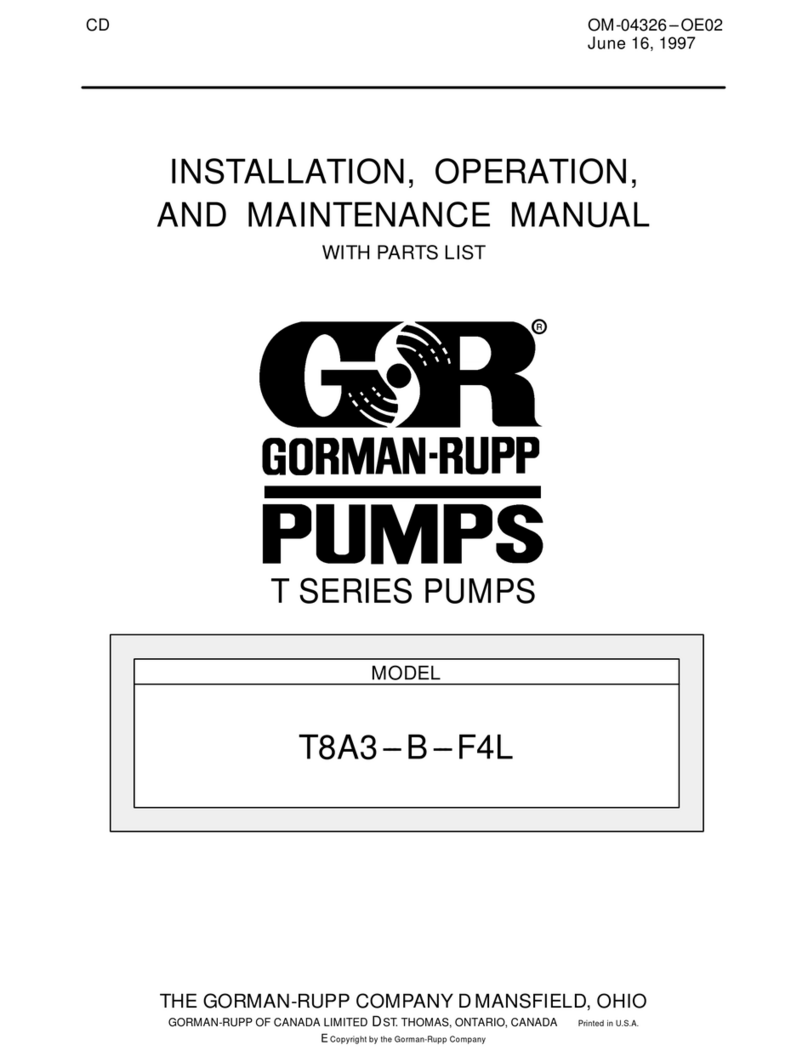
GORMAN-RUPP
GORMAN-RUPP SUPER T SERIES Installation, operation and maintenance manual

Sulzer
Sulzer AS 0530 Installation and operating instructions
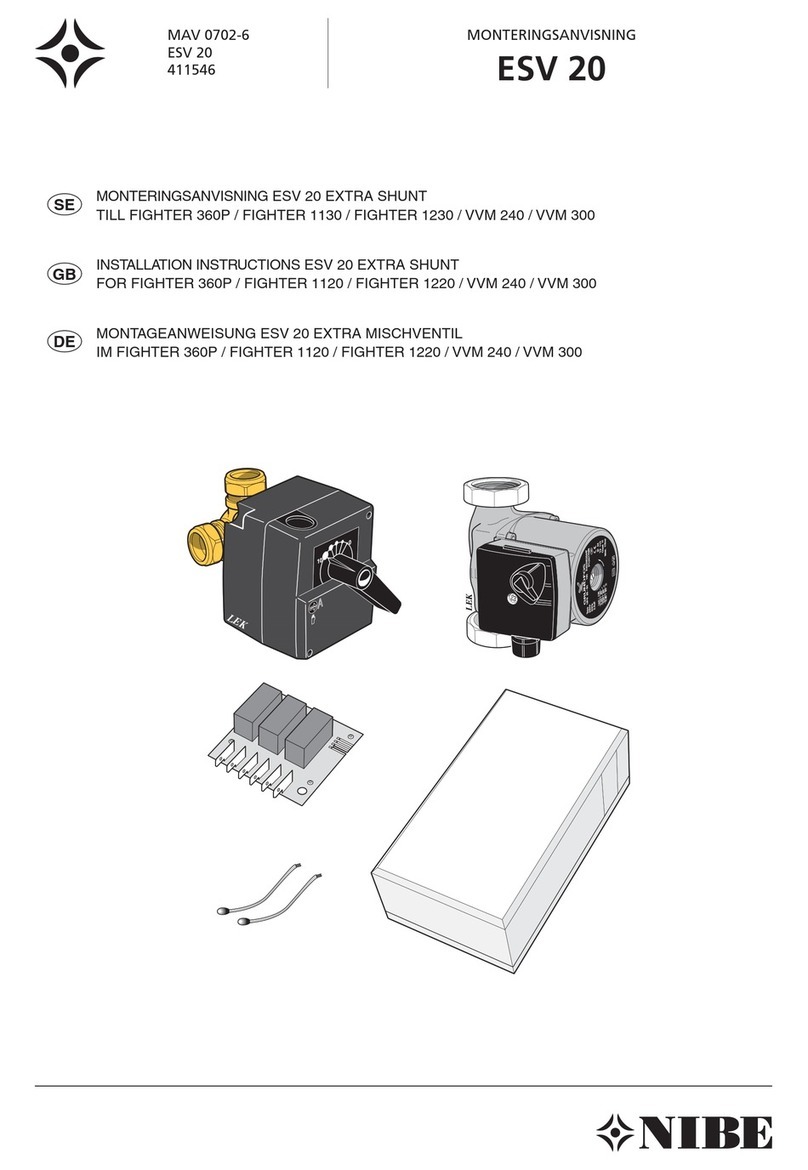
Nibe
Nibe ESV 20 installation instructions
Silicon Solar
Silicon Solar AQUAJET-MAXFLOW-50 user manual
